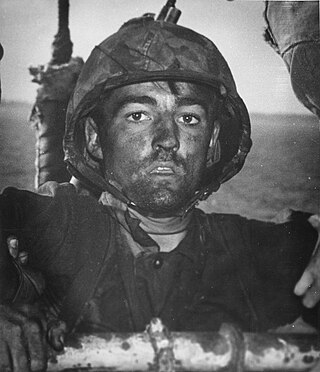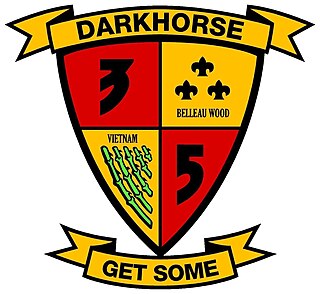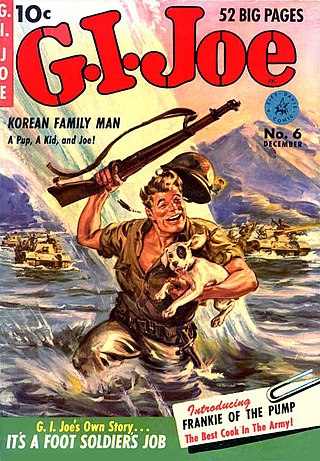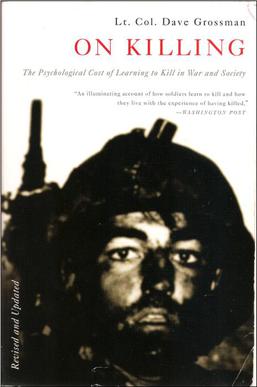
A Vietnam veteran is an individual who performed active military, naval, or air service in the Republic of Vietnam during the Vietnam War.
Post-traumatic stress disorder (PTSD) is a mental and behavioral disorder that develops from experiencing a traumatic event, such as sexual assault, warfare, traffic collisions, child abuse, domestic violence, or other threats on a person's life or well-being. Symptoms may include disturbing thoughts, feelings, or dreams related to the events, mental or physical distress to trauma-related cues, attempts to avoid trauma-related cues, alterations in the way a person thinks and feels, and an increase in the fight-or-flight response. These symptoms last for more than a month after the event. Young children are less likely to show distress, but instead may express their memories through play. A person with PTSD is at a higher risk of suicide and intentional self-harm.
Psychological trauma is an emotional response caused by severe distressing events that are outside the normal range of human experiences. It must be understood by the affected person as directly threatening the affected person or their loved ones with death, severe bodily injury, or sexual violence; indirect exposure, such as from watching television news, may be extremely distressing and can produce an involuntary and possibly overwhelming physiological stress response, but does not produce trauma per se. Examples include violence, rape, or a terrorist attack.

Combat stress reaction (CSR) is acute behavioral disorganization as a direct result of the trauma of war. Also known as "combat fatigue", "battle fatigue", or "battle neurosis", it has some overlap with the diagnosis of acute stress reaction used in civilian psychiatry. It is historically linked to shell shock and can sometimes precurse post-traumatic stress disorder.
Acute stress reaction and acute stress disorder (ASD) is a psychological response to a terrifying, traumatic or surprising experience. Combat stress reaction (CSR) is a similar response to the trauma of war. The reactions may include but are not limited to intrusive or dissociative symptoms, and reactivity symptoms such as avoidance or arousal. It may be exhibited for days or weeks after the traumatic event. If the condition is not correctly addressed, it may develop into post-traumatic stress disorder (PTSD).
Peer support occurs when people provide knowledge, experience, emotional, social or practical help to each other. It commonly refers to an initiative consisting of trained supporters, and can take a number of forms such as peer mentoring, reflective listening, or counseling. Peer support is also used to refer to initiatives where colleagues, members of self-help organizations and others meet, in person or online, as equals to give each other connection and support on a reciprocal basis.

3rd Battalion, 5th Marines is an infantry battalion in the United States Marine Corps. The battalion is based at Marine Corps Base Camp Pendleton, California and consists of approximately 1,000 Marines and Fleet Marine Force Navy personnel. The 3rd Battalion falls under the command of the 5th Marine Regiment which falls under the command of the 1st Marine Division.

War comics is a genre of comic books that gained popularity in English-speaking countries following World War II.

On Killing: The Psychological Cost of Learning to Kill in War and Society is a book by Dave Grossman exploring the psychology of the act of killing and the military law enforcement establishments attempt to understand and deal with the consequences of killing. The book is based on S.L.A. Marshall's theory that the majority of soldiers in war do not ever fire their weapons due to an innate resistance to killing.

Thomas "Tom" Calloway Lea III was an American muralist, illustrator, artist, war correspondent, novelist, and historian. The bulk of his art and literary works were about Texas, north-central Mexico, and his World War II experience in the South Pacific and Asia. Two of his most popular novels, The Brave Bulls and The Wonderful Country, are widely considered to be classics of southwestern American literature.
Jonathan Shay is an American doctor and clinical psychiatrist. He holds a B.A. from Harvard (1963), and an M.D. (1971) and a Ph.D. (1972) from the University of Pennsylvania. He is best known for his publications comparing the experiences of Vietnam veterans with the descriptions of war and homecoming in Homer's Iliad and Odyssey.
Combat Stress is a registered charity in the United Kingdom offering therapeutic and clinical community and residential treatment to former members of the British Armed Forces who are suffering from a range of mental health conditions; including post traumatic stress disorder (PTSD). Combat Stress makes available treatment for all Veterans who are suffering with mental illness free of charge.
Shell shock is a term that originated during World War I to describe the type of post-traumatic stress disorder (PTSD) that many soldiers experienced during the war, before PTSD was officially recognized. It is a reaction to the intensity of the bombardment and fighting that produced helplessness, which could manifest as panic, fear, flight, or an inability to reason, sleep, walk, or talk.

China Marine: An Infantryman's Life after World War II is the second memoir written by United States Marine Corporal Eugene B. Sledge, published posthumously with foreword by Stephen E. Ambrose, without subtitle, on May 10, 2002 by University of Alabama Press It was republished in paperback with the full title by Oxford University Press in July 2003. This book is the sequel to his first, better known, memoir, With the Old Breed: At Peleliu and Okinawa and Ambrose identifies it as the only account of the Marines stationed in postwar China. It has recently achieved wider public recognition as credited source material for the 2010 HBO miniseries The Pacific.

"The Builder" is a science fiction short story by American writer Philip K. Dick. It was first published in the magazine Amazing Stories, in December, 1953-January 1954, with illustration by Ed Emshwiller. Dick had submitted many short stories to magazines and made approximately fifteen sales before becoming a client of the Scott Meredith Literary Agency. This was his first SMLA submission, received by SMLA on July 23, 1952. His second SMLA submission was Meddler, received by SMLA on July 24, 1952. The SMLA file card for "The Builder" shows it was submitted to mainstream magazines The Atlantic Monthly and Harper's before it was submitted to Amazing Stories and has an SMLA sub-agent's notation, "IT ISN'T SCIENCE FICTION".
Bessel van der Kolk is a Dutch psychiatrist, author, researcher and educator. Since the 1970s his research has been in the area of post-traumatic stress. He is the author of The New York Times best seller, The Body Keeps the Score.
Gregory Van Maanen is an artist who has been exhibiting work since 1988. He has had several solo shows at Cavin-Morris Gallery in New York as well as a solo show at Rutgers University. His work has been widely shown in group exhibitions and Van Maanen’s art is in the permanent collections of the New Orleans Museum of Art, First Bank of Minneapolis, National Vietnam Veterans Art Museum, New Jersey State Council of the Arts, Jersey City Museum, Morris Museum, and others.

Sgt. Will Gardner is an American film directed and written by Max Martini. The film stars Martini, Omari Hardwick, Dermot Mulroney, Gary Sinise, and Robert Patrick, telling the story of a disabled Iraq War veteran, Will Gardner, who is suffering from traumatic brain injury (TBI) and posttraumatic stress disorder (PTSD) he sustained while in combat. After a series of setbacks, he goes on a cross-country motorcycle journey to reassemble his life and his family.

WWII lasted from September 1st, 1939 until September 2nd, 1945. The death toll during WWII has been estimated to be between 35,000,000 and 60,000,000. However, the exact number is unknown. With all those fatalities, it should not be surprising that it left so many lasting effects on the survivors. There have been many terms for these lasting effects over the decades. These terms include, but are not limited to, shell sock and combat fatigue. In 1980, the diagnosis of PTSD was added to the newly published DSM 3.
"Part Seven" is the seventh episode of the American war drama miniseries The Pacific. The episode was written by co-executive producer Bruce C. McKenna, and directed by supervising producer Tim Van Patten. It originally aired on HBO on April 25, 2010.










